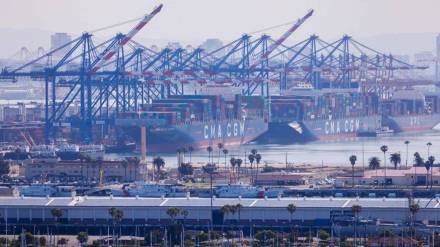By Afaq Hussain
In a major announcement during the recent G20 meeting in New Delhi, the India-Middle East-Europe Economic (IMEC) Corridor has emerged as a transformative opportunity to catapult Indian ports to the forefront of global trade. This ambitious corridor also reflects India’s steadfast commitment to strengthening its maritime trade infrastructure, signalling a forward-looking approach to economic advancement. It also presents India with an opportunity to expand its successes under the regional Security and Growth for All in the Region (SAGAR), and the domestic Sagarmala initiatives. With shifting dynamics in global trade, Indian sea ports have undergone significant enhancements to increase their global competitiveness.
This includes infrastructural upgradations and trade facilitation measures, from the introduction of Direct Port Entry and Direct Port Delivery to the implementation of Centralized Parking Plazas, de-congestion of port areas, automated gate operation and RFID container tracking system. The initiation of the Unified Logistics Interface Platform (ULIP) stands as a major future step to bring together all logistics stakeholders onto a unified platform. Moreover, measures like faceless assessments, Port Community System (PCS) and other efficiency-driven initiatives have streamlined India’s maritime trade ecosystem, which could also be highlighted through a 20 percent reduction in import release time according to the latest National Time Release Study (TRS) conducted by the Central Board of Indirect Taxes and Customs (CBIC) in 2023 compared to 2020.
While the IMEC corridor is still at a nascent stage, it presents an opportunity to explore India’s role within and beyond its immediate boundaries. There is an untapped potential in linking IMEC across regions, including through India’s existing connectivity initiatives in its eastern neighbourhood and ASEAN countries, thus extending the reach and influence of this corridor. To align Indian ports with global best practices, the next phase of reforms must focus on further strengthening the infrastructure and digital connectivity. Addressing critical issues like low draft capacity, perishable goods handling infrastructure, fortified last-mile connectivity, a robust domestic logistics system, port mechanization, and improved inland waterways connectivity must be prioritized. The maritime sector is essential to India’s global trade activities, facilitating 95% of the country’s international trade through its sea ports.
The efficient functioning of these ports is not only crucial to India’s ambition of strengthening its manufacturing sector but also pivotal in establishing itself as a vital player in the global value chain. To realize this vision, initiatives focused on the development of Multimodal Logistics Parks (MMLP) need to be expedited, ensuring seamless cargo movement across diverse modes of transportation. Projects identified under the PM Gati Shakti program, particularly those related to MMLPs, must be executed promptly, in tandem with the full operationalization of Dedicated Freight Corridors, thereby ensuring swift and cost-effective goods transportation via rail. The journey towards trade facilitation at Indian ports has been marked by a sustained drive towards digitization, a move that has significantly enhanced efficiency and transparency.
Indian ports have witnessed a remarkable transition towards paperless trade, with further measures needed to complete this transition towards a fully paperless trade ecosystem. This encompasses the integration of various systems to enable seamless message exchange among stakeholders in the trade ecosystem, encompassing Partner Government Agencies (PGAs) and Indian Customs Electronic Commerce/Electronic Data Interchange (ICEGATE), as well as exchanges between ICEGATE and custodians, particularly for processes like the Customs’ ‘Out of Charge’. Moreover, all stakeholders must transition to the Unified Logistics Interface Platform (ULIP) including the private stakeholders such as shipping lines and container freight stations for digital message exchanges.
Sustaining efforts to encourage the trade community to avoid hard copies should continue to remain a priority, achieved through capacity building and outreach initiatives led by relevant stakeholders, including port authorities and customs authorities. As the global momentum towards green ports is gaining traction, India must also outline a strategic blueprint for the transition towards Green Ports. This entails the integration of renewable energy sources, adopting eco-friendly and climate-resilient practices in port operations. Adhering to the International Maritime Organization’s alignment with the 9 UN Sustainable Development Goals, which encompasses mandates on safe, efficient, and sustainable ports, becomes paramount.
Incorporating green initiatives like enhancing the use of solar energy at ports, setting benchmarks for zero-emission trucks and port equipment, and participating in green shipping corridors akin to the United StatesSingapore corridor are vital steps towards achieving this end. As India embarks on a journey of deeper integration into the global supply chains, technological innovation and infrastructural upgrades at its ports will be pivotal. Coordinated efforts from various stakeholders within the port ecosystem alongwith international collaborations have the potential to elevate India’s role in the global value chains, propelling the nation closer to its aspirational goal of a USD 5 trillion-dollar economy. The pursuit of smart ports and sustainable practices is not only a strategic necessity but also a beacon guiding India towards a prosperous and environmentally conscious future in the realm of global trade.
The author is Co-Founder and Director at Bureau of Research on Industry and Economic Fundamentals (BREIF), New Delhi.
Disclaimer: Views expressed are personal and do not reflect the official position or policy of Financial Express Online. Reproducing this content without permission is prohibited.
